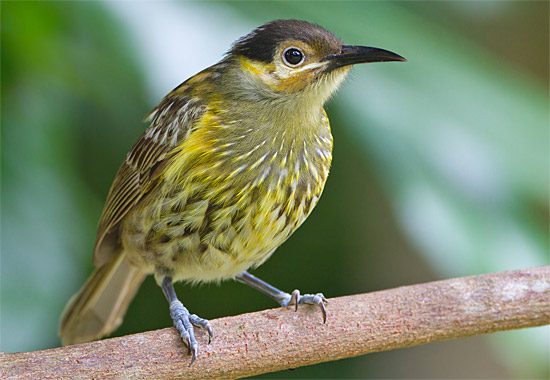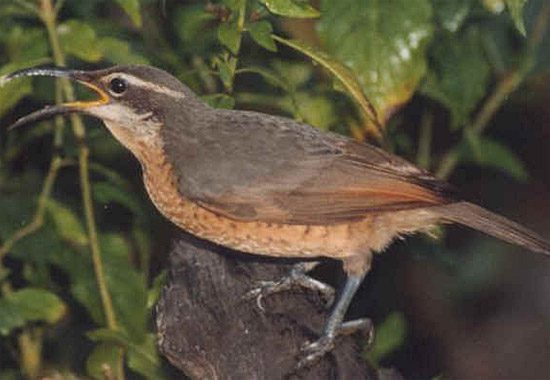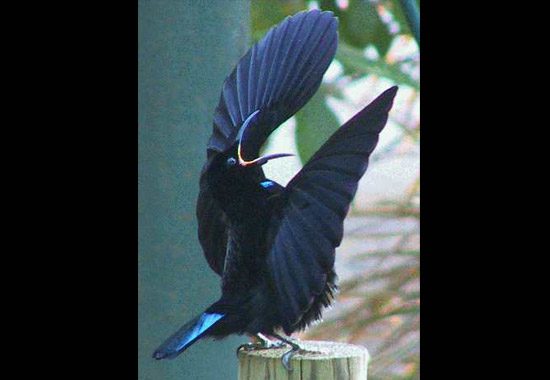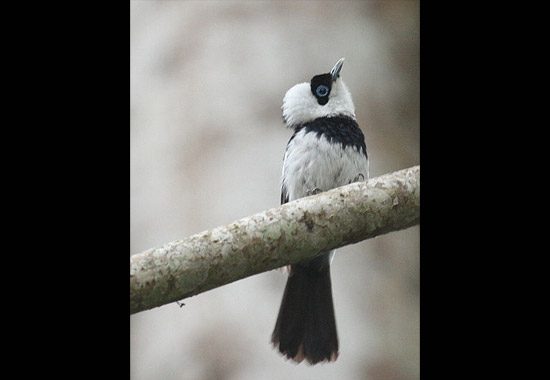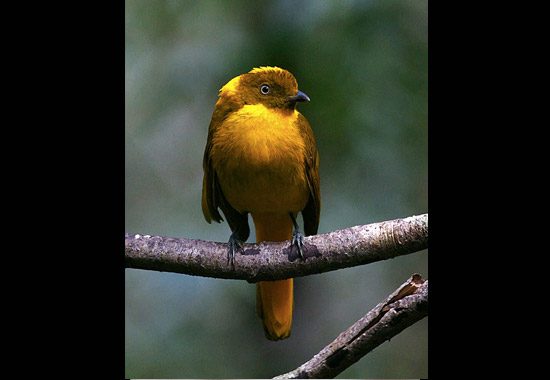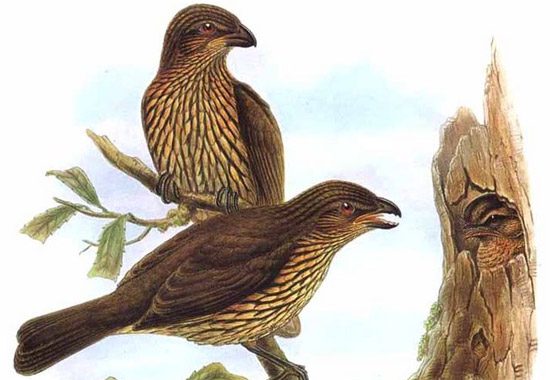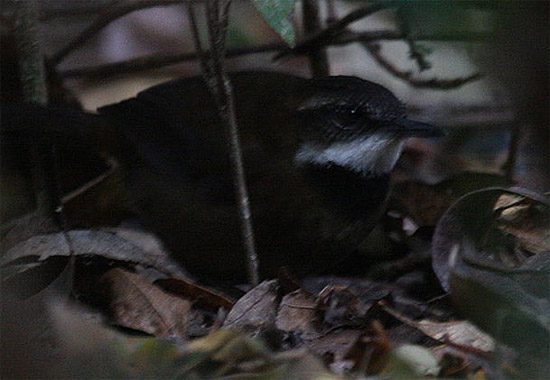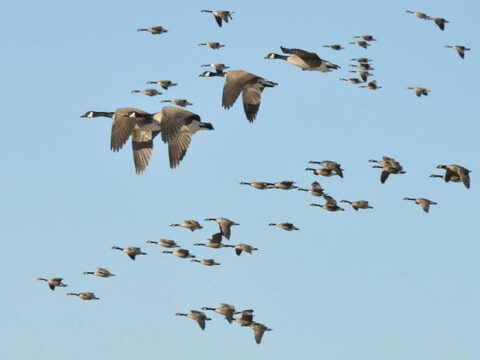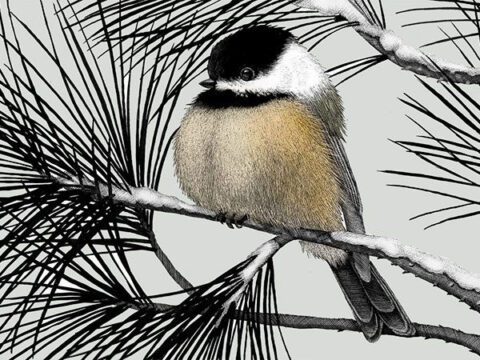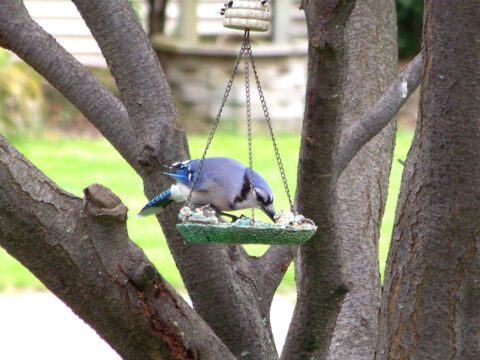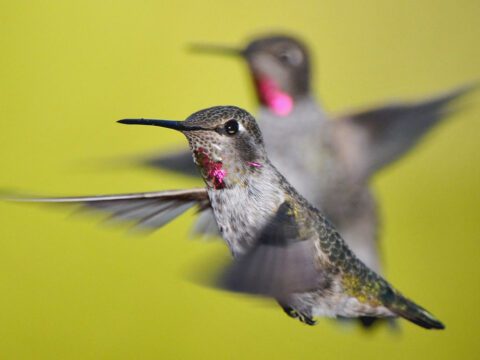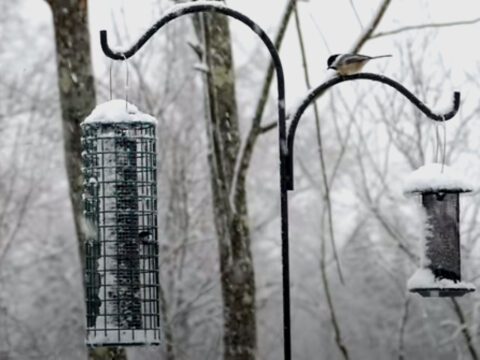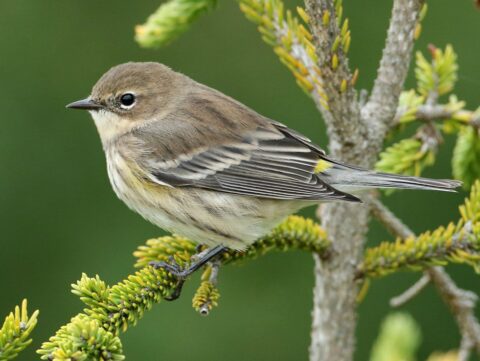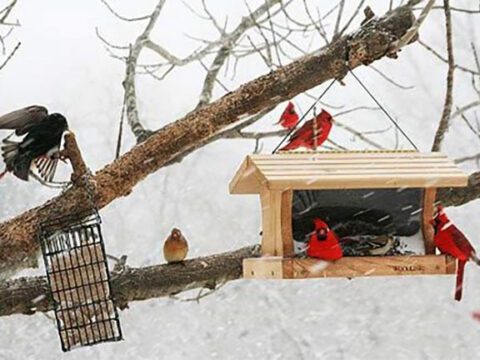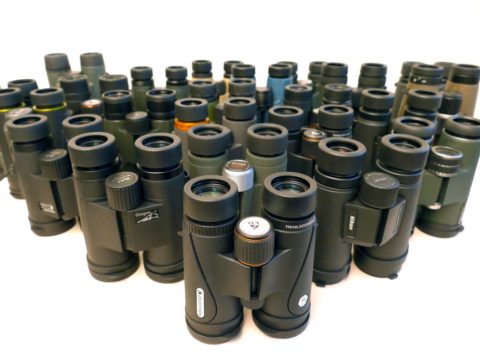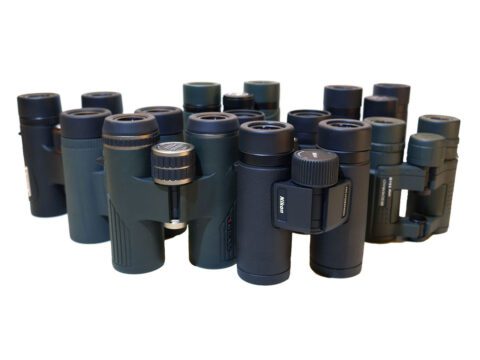Eleven Out of Twelve: a Tour of Australia’s Wet Tropics Endemics (Part 1)
By Hugh Powell May 4, 2012
Endemic #1: Macleay's Honeyeater. Photo by JJ Harrison. 
Endemic #2: Victoria's Riflebird, female. Photo by Kelson via Wikipedia. 
Endemic #2: Victoria's Riflebird, male. Photo by Kelson via Wikipedia. 
Endemic #3: Pied Monarch. Photo by Tim Lenz. 
Endemic #4: Golden Bowerbird. Photo by David Cook via Creative Commons. 
Endemic #5: Tooth-billed Bowerbird. Painting by Richard Bowdler Sharpe ca. 1900. 
Endemic #6: Fernwren, Photo by Tim Lenz.
This is Part 1 of an account—for any of you who love tales of unusual birds in unusual places—of a recent trip to Australia’s Wet Tropics region near Cairns, Queensland. In this Part we will discuss: Macleay’s Honeyeater, Victoria’s Riflebird, Pied Monarch, Golden Bowerbird, Tooth-billed Bowerbird, and the abominable Fernwren. Read Part Two here.
Birders love endemics—species you can see in only one place in the entire world. They provide excellent incentive to travel and, once you see them, you carry their memories in your mind like stamps in a passport. And Australia is a fantastic place for endemics. I saw my first endemic early on my first morning—an Australian Brush-Turkey strutting along a footpath at the Cairns Botanic Gardens, its bright-red head as bare as a vulture’s.
When talking about Australian endemics, it helps to be specific. As a result of its geographic isolation, Australia is crawling with them. And not just kangaroos and koalas; Australia has some 330 bird species that occur noplace else. (The similarly sized continental U.S. holds only about 16 endemics.) I shook off the thrill of the brush-turkey and set my mind on the dozen endemic species that can be found within a half-day’s drive of Cairns.
I was visiting Australia’s Wet Tropics, a slender band of World Heritage Area rainforests surrounded by sugarcane and dairy farms, where 12 endemic birds live among some 350 other species. Scattered among the tiny towns and backroads are a handful of lodges that specialize in helping birders see the local specialties, and I was lucky enough to go birding there in late April with a couple of other journalists (Ed Williams of BirdLife Australia and Mike Weedon of UK’s Bird Watching magazine). The places range from modest homes nestled under rainforest canopies to posh ecoresorts with gourmet chefs, exquisite settings, and amenities fully capable of satisfying a group’s nonbirding members. After a week I had found 11 of the 12 endemics, and as I followed from one to the next, they led me to find a couple hundred of the region’s astounding bird species.
My first Wet Tropics endemic was a group of Macleay’s Honeyeaters. They were sipping nectar from a feeder and dodging attacks by a temperamental Helmeted Friarbird. This was on the back deck of Cassowary House, the home of Sue and Phil Gregory, just outside the town of Kuranda. To my eye, honeyeaters are a bit like the dazzlingly diverse tanagers of Central and South America. Though honeyeaters don’t reach the gaudy heights of, say, Paradise Tanagers, they’re more elegantly proportioned, with longer necks and gracefully curved bills. And like tanagers, some species that look unimpressive in the field guide take on a complex beauty when seen in real life. Macleay’s is like that—on paper, a scruffy mix of yellow streaks on a brownish green body. In life, the green acquires a shimmer and the yellow streaks seem sharply painted, floating over the background color.
The second endemic showed up the next morning as the gloom of dawn simmered out of the rainforest. We had gotten up early to watch musky rat-kangaroos—sharp-featured, reddish-brown creatures thought to be early ancestors of kangaroos. Through the dripping palms and vines came a large songbird with a finely streaked breast, buffy eyebrow, and a long, hefty, decurved bill. This was a gentle introduction to the most fantastical of all bird families, the birds-of-paradise—a female Victoria’s Riflebird. Two days later I saw a male, an absurd creature with a glossy black cape of feathers and flashes of electric blue in the throat, crown, and tail. The male’s feathers (but not the female’s) make a distinctive rustling in flight, like the sound of taffeta. A few times I saw a male perched on a high snag, puffing out its feathers and raising its rounded wings over its head one at a time—a young male practicing a courtship display.
One of the most famous rivers in Queensland’s Wet Tropics is the Daintree, where lowland rainforest remains and people take riverboat rides to see crocodiles, Black-necked Storks, and Great-billed Herons. Trish and Andrew Forsyth, who run Red Mill House, took me out birding here and found a Buff-breasted Paradise-Kingfisher still hanging around—most have left for winter in Papua New Guinea by the end of April. In a giant mixed flock of foraging birds we found at least three Pied Monarchs—my third endemic. Though they look superficially like flycatchers, they forage more like kinglets, constantly flicking, hopping, and clinging momentarily to the undersides of tree branches. As the name suggests, they’re black and white, but a rich white patch on the neck seems especially luminous and rich, almost like the bird is wearing a ruff.
West of Cairns, at about 2,000 feet elevation, lies a volcanic region called the Atherton Tablelands. It’s a mite cooler than the lowlands, and endemics lurk in the patches of misty rainforest that cling to peaks. A remarkable naturalist named Alan Gillanders showed us some of his favorite spots, including Mt. Hypipamee National Park, where my fourth endemic, the Golden Bowerbird, builds its monuments. The bowers are easier to find than the birds, and Gillanders led us right up to one. It wasn’t the immaculately curated, color-coordinated showpiece that you may have seen in magazines—those belong to other species. Golden Bowerbirds pile curved sticks into impressively untidy heaps about four feet high. The collection looks a bit like a gigantic one of those chocolate-covered chow mein spiders that kids make at Halloween. The twigs are in fact all stuck together by a curious, invisible fungus that grows through them shortly after the bird puts them in place. As for the bird itself, we heard it before we saw it. The song, as such, is one of the most unusual noises I’ve ever heard come out of a bird—a rhythmic rolling that sounds like a piece of machinery. The bird was perched low in the understory, a smear of lustrous yellow against the dim light.
(Later on, Jon Nott of Rose Gums Wilderness Retreat took us out to see a platypus sculling through a lily pond. Though not technically a regional endemic—or a bird—it was one of the highlights of the trip all the same.)
My fifth endemic was another bowerbird, but it was up to me to ferret it out alone. Our group had seen one a few days earlier, but it was that worst sort of sighting where three people are looking at a cluster of leaves that may or may not be shaking. In one moment, the head of a Tooth-billed Bowerbird pops out, looks at the assembled birders first with one eye and then the next, and then disappears. One person shouts, “Tooth-billed Bowerbird!”, the next shouts, “Tooth-billed Bowerbird!”, and the third is looking a little too far to the right. As annoying as it is at the time, this is usually for the best, because it forces you to go out and get a proper, satisfying look at the bird yourself. I got some advice on where to find one from a free birding app for the region, and that’s how I spent three hours walking around Wongabel State Forest.
I saw displaying riflebirds, an endemic scrubwren and an endemic robin (more about them in Part 2), and heard the amazing sci-fi sounds of duetting Eastern Whipbirds (listen) and the aggravated mewling of Spotted Catbirds (listen)—a big, green-backed, yellow-billed relative of the bird I was seeking. My problem was that Tooth-billed Bowerbirds spend April sitting quietly in the midstory. The best time to find them is during their breeding season, when they give out hoarse squawks and turn over leaves, pale side up, on the forest floor to use as a sort of courting stage.
Just as I was coming back out of the forest, I heard a quick rush of wings and somehow knew, by its very unobtrusiveness, that I’d found one. It turned out these birds really are the kind that look drab in life as well as in the field guide—a brown bird with heavy brown streaks and a thick, slightly hooked black bill. Still, there was something about this bird that struck me—maybe it was the just-in-time sighting, or its patient silence just off the trail, or the simple weirdness of this family, the heftiness of the bird, its unfamiliar proportions, its thick neck and short tail, that brought home what a strange place I had been walking around in for the past week.
And that’s it—you can stop reading the post at this point, because the sixth endemic in Part 1 is the one I didn’t get: the Fernwren. We thought we’d heard one about halfway through the week, but it turned out to be the rare-but-not-endemic Chestnut-breasted Cuckoo (more on that in Part 2). We listened for one at Mt. Hypipamee, as the thrill of the Golden Bowerbird was settling in, while German tourists strode up the path, out of sight, and back down again. Next I followed the app’s suggestions to a forest at nearby Lake Barrine National Park. There I saw many beautiful honeyeaters, more riflebirds than I could have imagined possible back on day 1, plus clouds of vireo-like “gerygones” twittering overhead, screeching cockatoos, bucketloads of brush-turkeys, and little Red-browed Finches making nests in tree ferns.
But no Fernwrens. I spent the last 45 minutes before I left the tablelands listening for these shy little ground birds beside a creek, as wait-a-while vines tore at my clothes, and some (probably endemic) species of chigger bored into my legs, and the region’s infamous heat-seeking leeches inched up my trousers. Of course, people always say you have to leave something to come back for. And I tried to repeat that to myself as I drove toward the airport.
In Part 2, I recount an extraordinary day birding on Mt. Lewis near the town of Mareeba, where a quiet, patient guide named Del Richards helped us find the other six endemics in a single afternoon. I saw several of these species again, elsewhere in my travels, but Mt. Lewis was the first place I saw these six, and it stands out as an epic day of birding in a strange land.
(Images: Macleay’s Honeyeater by JJ Harrison; Victoria’s Riflebirds by Kelson; Pied Monarch and Fernwren by Tim Lenz; Golden Bowerbird by David Cook, all Creative Commons licensed or used with permission; Tooth-billed Bowerbird painting by Richard Bowdler Sharpe [public domain]. Look for more stories about science and conservation in northeastern Australia in upcoming issues of Living Bird magazine.)

All About Birds
is a free resource
Available for everyone,
funded by donors like you
American Kestrel by Blair Dudeck / Macaulay Library
